Trees Birds Mammals Fish Amphibians Reptiles
Wild Algarve
Bookshop
Geopora sumneriana (Cooke) M. Torre. - Cedar Cup
Phylum: Ascomycota - Class: Pezizomycetes - Order: Pezizales - Family: Pyronemataceae
Distribution - Taxonomic History - Etymology - Toxicity - Identification - Reference Sources
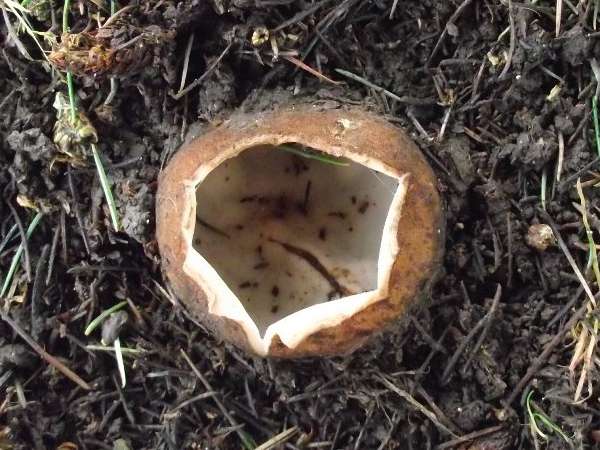
This large cup fungus develops initially as an underground sphere before breaking through the soil surface and opening up to form a crown-shaped cup.
Geopora sumneriana is almost invariably associated with cedar trees (Cedrus spp.). Although there are one or two references in the literature to this ascomycete appearing beneath Yews (Taxus baccata) in Britain, it is possible that there were cedars nearby (or there may have been cedars nearby in the recent past.)
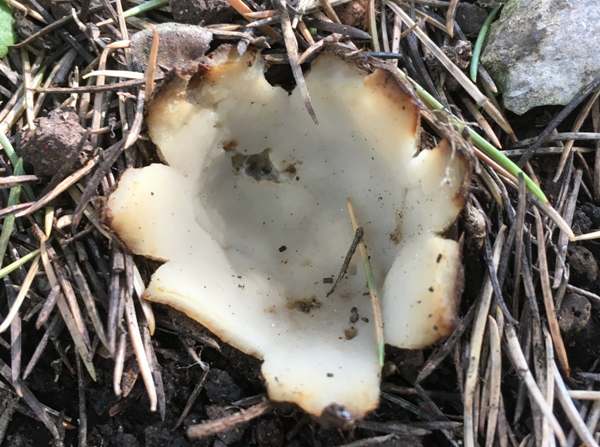
The Cedar Cup shown above is fully mature, and the rays have opened out as far as they will go.
Distribution
Geopora sumneriana is a European ascomycete, and it is most common in Central Europe, where cedar trees (Cedrus spp.) tend to be concentrated.
Cedar Cup is a rare find in Britain, perhaps mainly because cedars are non-native trees and their distribution is very patchy. If you travel along the M5 and M50 from Herefordshire through Worcestershire and in to Warwickshire, you will see quite a lot of cedars, and perhaps that is why many of the official records of Geopora sumneriana are from an area just south of the Malvern Hills. Most British sightings of this late winter and spring fruiting cup fungus are from locations further south in England, notably Cambridgeshire and Kent. In Britain, Cedar Cup was reported in exceptionally large numbers during the winter of 2016-17.
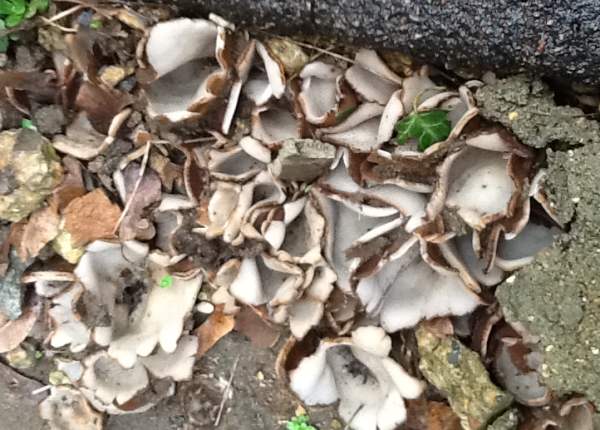
Taxonomic history
Originally described by Mordecai Cooke and named Peziza sumneriana, this cup fungus was for many years known as Sepultaria sumneriana, a name given to it in 1895 by George Edward Massee (1850 - 1917), co-founder and first president of the British Mycological Society. Its present accepted name, Geopora sumneriana, dates from a 1976 publication by Spanish mycologist M. de la Torre in Anales del Instituto Botanico A.J. Cavanilles.
Synonyms of Geopora sumneriana include Sepultaria sumneriana (Cooke) Massee, Sepultaria sumneri (Berk.) Boud., and Peziza sumneriana Cooke.
Etymology
The generic name Geopora means earth cup, appropriate for cup fungi that grow on/in earth. The specific epithet sumneriana may be honouring American biologist Francis Bertody Sumner (1874 - 1945) - if you know differently please contact us. The synonymous generic name Sepultaria means underground tomb, and as the cup fungi in this group develop underground and are usually more than half buried even when the cups have opened, it seems quite appropriate.
Toxicity
Poisonous if eaten raw, Geopora sumneriana is said by some authorities to be toxic even if cooked. In any case the flesh is insubstantial and, in view of the rarity of these cup fungi, it would be irresponsible to gather them.
Identification Guide
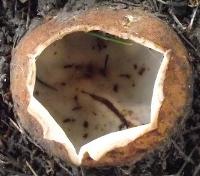 |
Fertile (inner) surface
Pale cream to light greyish beige on the smooth inner (hymenial or spore-bearing) surface, Cedar Cups develop over several months as underground spheres before breaking through the surface of the soil and splitting open in the form of typically 5 to 8 irregular rays. Up to 5cm tall, the cups are typically 5 to 7cm across when fully open. The specimen shown here is not yet fully mature, and its star-like rays will fold back further to create a broader, shallower cup with a crown-like rim. (Like most cup fungi the flesh of the Cedar Cup is quite brittle.) |
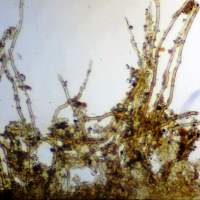 |
Infertile (outer) surface and stem
Varying in colour from orange-brown to reddish-brown, the outer surface is infertile and covered in curly brown septate fine hairs up to 2mm in length with rounded ends and covered in numerous clear crystals.
|
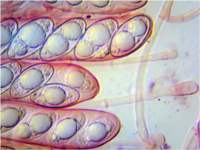 |
Asci
Hyaline, cylindrical, 330 - 370µm x 16 - 22µm, with eight spores per ascus.
<
The septate paraphyses are cylindrical, 3-4µm in diameter with slightly clavate with 5-9µm diameter tips . |
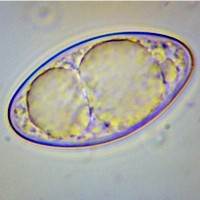 |
Spores
Ellipsoidal-fusiform, smooth, 27-37 x 13-16µm; each usually containing two large oil drops. (The spores are produced on the shiny inner surface of the cup.)
Spore print
White |
Odour/taste |
Not distinctive. |
Habitat & Ecological role |
On dryish soil beneath cedar trees, usually in small groups. |
Season |
January to May in Britain. |
Similar species |
Geopora arenosa and Geopora tenuis are much smaller and paler; they appear in dry sandy places, the latter most particularly on sand dune systems.
Sarcoscypha austriaca, the Scarlet Elf Cup, is bright red
and grows on dead twigs and branches in mossy woods and sometimes under damp hedgerows. |
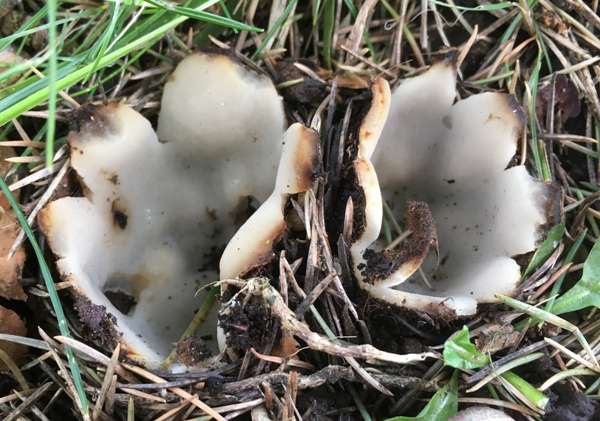
Reference Sources
Fascinated by Fungi, 2nd Edition, Pat O'Reilly 2016, reprinted by Coch-y-bonddu Books in 2022.
Dictionary of the Fungi; Paul M. Kirk, Paul F. Cannon, David W. Minter and J. A. Stalpers; CABI, 2008
Dennis, R.W.G. (1981). British Ascomycetes; Lubrecht & Cramer; ISBN: 3768205525.
Dennis, R.W.G. (1981). British Ascomycetes; Lubrecht & Cramer; ISBN: 3768205525.
Breitenbach, J. & Kränzlin, F. (1984). Fungi of Switzerland. Volume 1: Ascomycetes. Verlag Mykologia: Luzern, Switzerland.
Medardi, G. (2006). Ascomiceti d'Italia. Centro Studi Micologici: Trento.
Taxonomic history and synonym information on these pages is drawn from many sources but in particular from the British Mycological Society's GB Checklist of Fungi.
Acknowledgements
This page includes pictures kindly contributed by Simon Harding, Bill Prince and Richard Shotbolt.
Top of page...
Fascinated by Fungi. Back by popular demand, Pat O'Reilly's best-selling 450-page hardback book is available now. The latest second edition was republished with a sparkling new cover design in September 2022 by Coch-y-Bonddu Books. Full details and copies are available from the publisher's online bookshop...